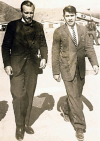Origin of the Nuñoa, Perú High Altitude Field Research Site and How It Shaped Our Understanding of Functional Adaptation to High-Altitude Stressors
- PMID: 40219710
- PMCID: PMC11992547
- DOI: 10.1002/ajhb.70031
Origin of the Nuñoa, Perú High Altitude Field Research Site and How It Shaped Our Understanding of Functional Adaptation to High-Altitude Stressors
Abstract
The study of physical growth and development of Indigenous children from Nuñoa, Perú, in the 1960s showed that growth in body size and skeletal maturation was slow and delayed, while growth in lung volume, measured by forced vital capacity (FVC), was accelerated. Hence, I proposed that the high functional adaptation of high-altitude natives was influenced by developmental processes. To test this hypothesis, my co-investigators and I conducted two sets of major physiological studies at high altitudes. The first studies were conducted in Cusco (3400 m) and Puno (3840 m), Perú. This research showed that the FVC and aerobic capacity of low-altitude Peruvian urban natives acclimatized to high altitudes during the developmental period were similar to those of high-altitude urban natives. In contrast, Peruvian and US participants acclimatized during adulthood did not have the same FVC and aerobic capacity as the high-altitude urban natives. The second set of studies was carried out in the city of La Paz, Bolivia (3752 m), and included Europeans who were acclimatized to high altitudes at different ages. This research confirmed that acclimatization during the developmental period was a major component of the high functional adaptation among high-altitude urban natives. These conclusions have been confirmed by epigenetic studies, which demonstrated that acclimatization to high altitude leads to modifications in the activity of the DNA that facilitate adaptation during the developmental period.
© 2025 The Author(s). American Journal of Human Biology published by Wiley Periodicals LLC.
Figures








References
-
- Baker, P. T. 1963. Adaptation to High Altitude Cold in the Andes. Progress Report. Defense Technical Information Center.
-
- Baker, P. T. , and Little M. A., eds. 1976. “Man in the Andes.” In A Multidisciplinary Study of High‐Altitude Quechua. Dowden. Hutchinson & Ross.
-
- Bigham, A. W. , Wilson M. J., Julian C. G., et al. 2013. “Andean and Tibetan Patterns of Adaptation to High Altitude.” Ameican Journal of Human Biology 25: 190–197. - PubMed
Publication types
MeSH terms
LinkOut - more resources
Full Text Sources
Medical

